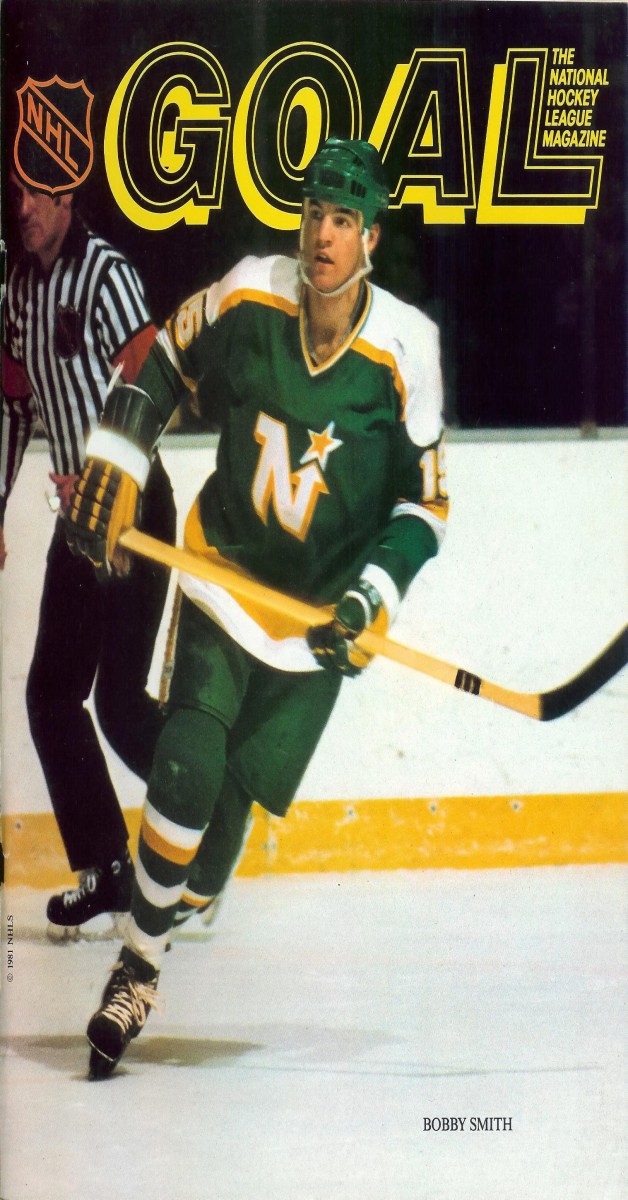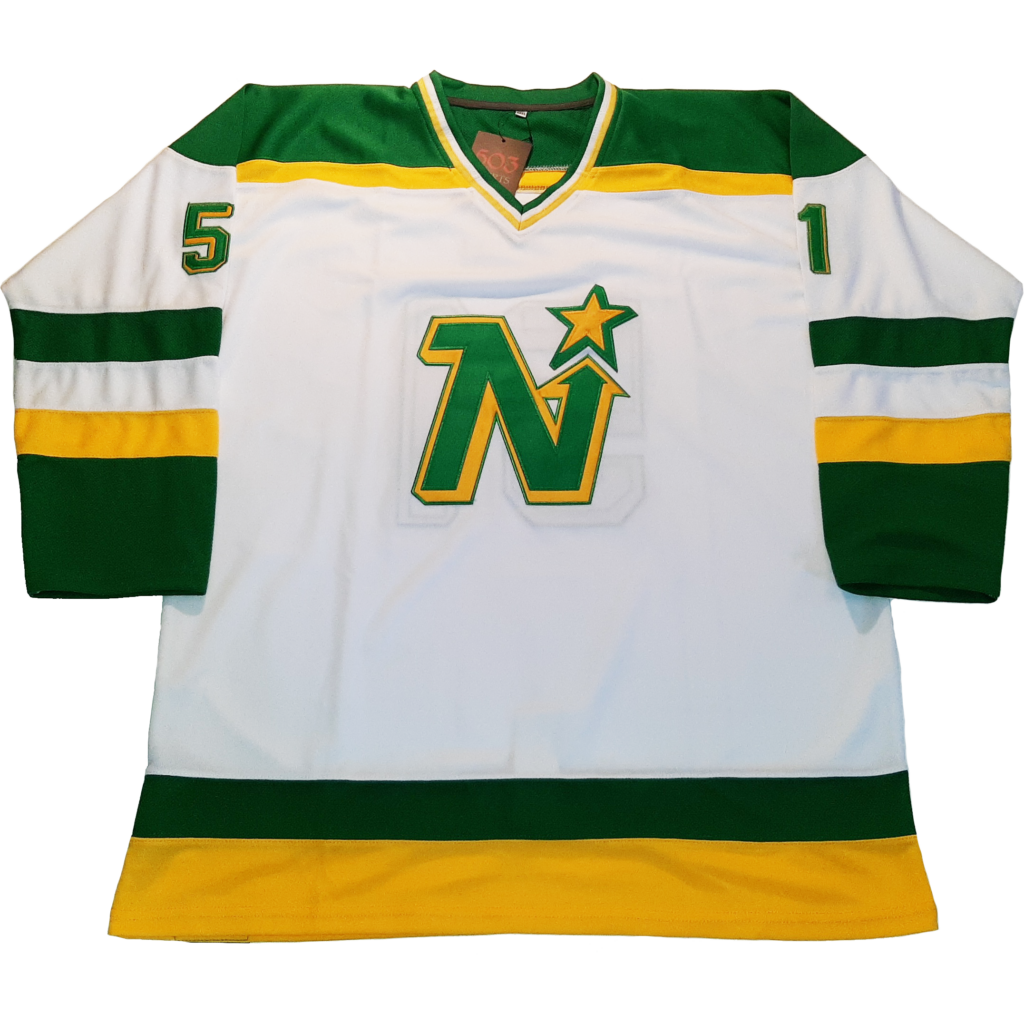National Hockey League (1967-1993)
Tombstone
Born: February 9, 1966
Moved: March 10, 1993 (announced relocation to Dallas)
First Game: October 11, 1967 (T 2-2 @ St. Louis Blues)
Last Game: April 15, 1993 (L 5-2 vs. Detroit Red Wings)
Stanley Cup Championships: None
Arena
Met Center, Bloomington, MN (15,000)
Opened: October 21, 1967
Demolished: December 13, 1994
Marketing
Team Colors:
Green, Gold, White (1967-1981)
Green, Gold, White, Black (1981-1993)
Ownership
Owners:
- 1967-1978: Walter Bush, Jr., Robert Ridder, and John Driscoll
- 1978-1990: George Gund & Gordon Gund
- 1990-1993: Norm Green
Retro north Stars
north Stars Apparel
When it comes to replica jerseys, look no further than Royal Retros, who put extraordinary detail into their fully customizable hockey sweaters.
Free Customization Included
Each jersey individually handmade
Any name and number
Heavyweight sewn tackle twill
100% polyester
Heavyweight fabric made to game standards
Fight strap included
Multiple colors and styles available. It’s not just jerseys, though. Royal Retros has North Stars T-shirts, hoodies, and hats. Order today, SAVE 10%, and rep old time Minnesota hockey!
Background
When the National Hockey League (NHL) decided to expand in March 1965, hockey-crazed Minnesota seemed like the perfect market for one of the six new teams. The league thought so as well, and less than a year later, in February 1966, a nine-person syndicate led by Walter Bush, Jr., Robert Ridder, and John Driscoll secured a team for the Twin Cities to be called The North Stars. The nickname was inspired by the state’s motto: “L’Étoile du Nord,” which is French for “The Star of the North”.
In the fall of 1966, ground was broken for a new arena in suburban Bloomington. The Met, as it would be known, sat across the street from the city’s Metropolitan Stadium, home of baseball’s Twins and football’s Vikings. On October 11, 1967, the North Stars played their home opener against fellow expansion team, the Oakland Seals. The North Stars triumphed 3 to 1 as former United States men’s national ice hockey team star Bill Masterson put the biscuit in the basket for the team’s first-ever goal.
Tragically, Masterson lost his life following an injury in a game against the Seals on January 13, 1968. It was a devastating blow to the new team, who then lost six straight games. They managed to recover later in the season and made the playoffs. However, they were eliminated by the Los Angeles Kings in the first round.
The following season, they missed the playoffs before starting a run of four straight post-season appearances starting in 1970. Attendance improved each year as Minnesota hockey fans embraced the North Stars.
Twin Competitors in the Market
For five years, the North Stars had the Twin Cities all to themselves. Then, in 1972, the World Hockey Association (WHA) debuted with 12 teams, half of them placed in cities with NHL teams, including Minneapolis/St. Paul. The rival Minnesota Fighting Saints played across the river in St. Paul. They started their inaugural season in the St. Paul Auditorium before moving to the brand-new St. Paul Civic Center in January 1973.
The Fighting Saints proved to be one of the more tenacious crosstown rivals offered by the WHA. Other NHL teams dispatched their local competition within a season or two, sometimes less, save for the Toronto Maple Leafs, who took three seasons to rid the market of the rebel Toros.
The North Stars were not as fortunate as the Fighting Saints (in two separate incarnations) hung around the Twin Cities for five seasons before going under for good. The established team was in the middle of their fourth straight playoff season when the Fighting Saints debuted. Unfortunately, they had failed to make it past the second round in their previous three attempts. Still, attendance was good for the North Stars as they averaged 15,319 fans for the 1971-72 season, the year before the Fighting Saints skated into town.
The Fighting Saints, in their first season, also made the playoffs, and though they exited in the first round of the WHA post-season tournament, averaged 5,862 fans per game. That, however, only put a very tiny dent in the North Stars’ numbers, as they averaged 15,264 per game while also being knocked out in the first round.
The following season it was pretty much the same case, except the North Stars missed the playoffs. The Fighting Saints wound up pulling in almost 6,500 per game before a second round series loss ended their sophomore season. The extremely popular University of Minnesota Golden Gophers hockey team, meanwhile, won that year’s Frozen Four.
The tables turned a bit for the 1974-75 pro season. The North Stars again missed the playoffs, while the Fighting Saints made their third straight post-season appearance. The U of M went to the Frozen Four for the second-straight year. The North Stars’ attendance dipped that year as the Fighting Saints’ peaked.
The battle raged on, but the Fighting Saints, burdened with a hefty payroll, succumbed halfway through the 1975-76 season. The North Stars thought they were finally in the clear until the WHA’s Crusaders turned up the following fall as the “New” Minnesota Fighting Saints. That version lasted only 42 games before calling it quits.
Minnesota North Stars vs. Fighting Saints Attendance
YEAR North Stars Fighting Saints TOTAL FANS U of M 67-68 11,861 (LR1) 68-69 12,919 (OOP) 69-70 14,317 (LR1) 70-71 14,503 (LR2) 71-72 15,319 (LR1) 72-73 15,264 (LR1) 5,862 (LR1) 21,126 73-74 15,251 (OOP) 6,484 (LR2) 21,735 F4/Champs 74-75 13,587 (OOP) 8,408 (LR2) 21,995 F4/RU 75-76 9,655 (OOP) 8,396 (Folded) 18,051 F4/Champs 76-77 9,084 (LR1) 6,211 (Folded) 15,295 77-78 8,666 (OOP)
LR1=Lost in Round 1, LR2=Lost in Round 2, OOP=Out of Playoffs
On the Verge of Extinction
Even with the WHA out of the market, the North Stars’ woes continued. They had missed the playoffs in three of their previous four seasons and had only managed two winning seasons since they joined the league in 1967. With the pro hockey market all to themselves for the 1977-78 season, they missed the playoffs once again and only managed to draw an average of 8,666 fans to The Met. The situation was dire indeed.
Merger With Cleveland Barons
While things looked gloomy in the Twin Cities, they were downright desperate in Cleveland. The Barons nearly folded in the middle of the 1977-78 season, and their prospects for returning the following season were nearly non-existent.
The Barons’ owners, George and Gordon Gund, devised a solution: Merge the Barons and North Stars, with the Gunds taking a majority stake in the new operation. It wasn’t the solution the league wanted, but it was better than seeing a franchise fold outright, something that hadn’t happened in the NHL since 1942.
The combined team kept the North Stars name, colors, branding, and home ice in Minnesota. They fared better in the standings and, eventually, the box office. However, it wasn’t enough for the Gunds, who felt a great hockey market like the Twin Cities should be showing more enthusiasm for pro hockey.
The brothers tried moving the team to the Bay Area, but the NHL rejected that idea. Instead, a plan was devised to allow the Gunds to sell the team to Norm Green and his business partner, former Hartford Whalers owner Howard Baldwin. The Gunds were then awarded an expansion franchise for the Bay Area. As part of the deal, the team that would become known as the San Jose Sharks was stocked with a number of Minnesota North Stars players.
The Finals and the Final Season in Minnesota
At the end of the 1990-91 season, the North Stars found themselves in the post-season, barley. Thus began an improbable run to the Stanley Cup Finals, where they lost to the Pittsburgh Penguins in six games. The following year, as part of the agreement with the club’s former owners, several players from the Finals team went to the San Jose Sharks. The core of the club remained, though.
Improving their record from the previous season, the team made the playoffs again, only to be eliminated by the Detroit Red Wings. Despite the team’s new-found success, Norm Green, who had become the sole owner, was looking to move the club.
At first, he had his eyes set on Orange County, California, and the new arena being built there. The NHL, though, had already awarded an expansion franchise to the Walt Disney Company. That team would become the Mighty Ducks of Anaheim.
The league instead allowed Green to move the team to Dallas, where they became the Dallas Stars.
Legacy
In 1994, the International Hockey League (IHL) established the Minnesota Moose. At the time, the IHL was moving teams out of small Midwestern towns and into big cities across the U.S., with hopes of possibly becoming a rival major league. The Moose spent two seasons in Minnesota before moving north to Winnipeg, Manitoba, a city that had just lost the NHL Jets to Arizona. The Manitoba Moose are currently members of the American Hockey League.
On June 27, 1997, the expansion Minnesota Wild was established, and NHL hockey finally returned to the Twin Cities in the fall of 2000 when the new team finally hit the ice.
Our friends at the Good Seats Still Available podcast did an episode on the Minnesota North Stars:
Minnesota North Stars Video
Minnesota North Stars at Hartford Whalers, January 3, 1993
In Memoriam
North Stars co-owner George Gund III passed away on January 15, 2013 after a bout with stomach cancer. Gund was 75 years old.
##


